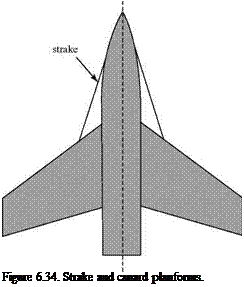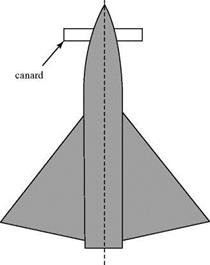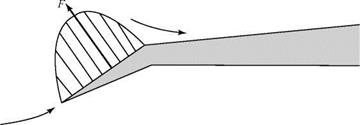Strakes and Canards
Strakes, also called leading-edge extensions are highly swept surfaces that are added to the wing at the wing root, shown in Fig. 6.34a. Their purpose is to cause leading – edge separation, resulting in a strong spiral vortex that sweeps back and over the wing, thereby providing vortex lift on the strake and added lift on the wing.
A canard, Fig. 6.34b is a separate miniature lifting surface placed forward of the main wing on an aircraft. Delta-wing aircraft must operate at a high angle of attack at low speeds (i. e., low dynamic pressure) to generate a sufficiently large lift coefficient to maintain flight. (The Concorde has a separate nose section that is angled downward for landing to improve pilot visibility.) At operational values of lift coefficient,
|
Figure 6.33. Leading-edge vortex flap. |
 |
 |
the delta-wing configuration exhibits a large nose-down pitching moment. The lifting canard supplies a nose-up pitching moment to counteract this behavior. A lifting canard also is useful for trim when flap deflection leads to the nose-down pitching moment of an aircraft. Careful canard design and placement can lead to beneficial mutual-interference effects between the canard and the main wing.












